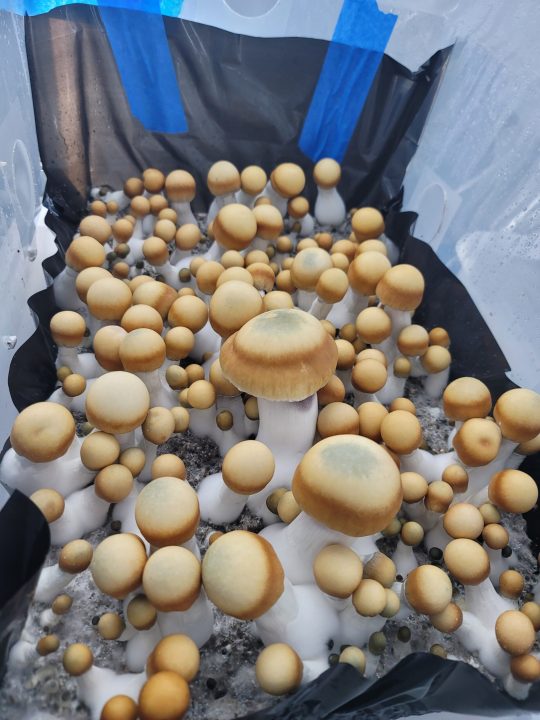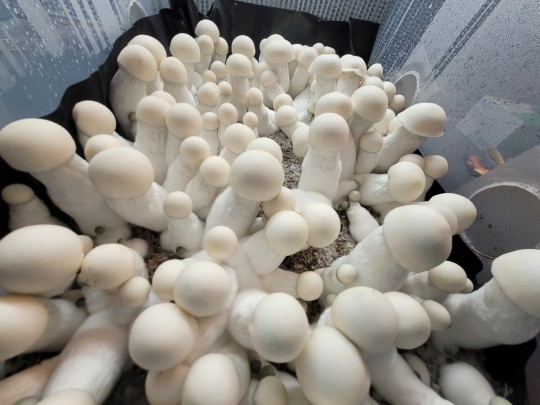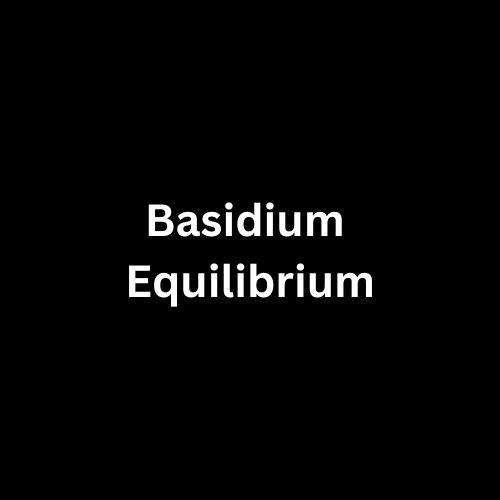Basidium Equilibrium is a world class vendor or psilocybe mushroom spores. https://basidiumequilibrium.com/
Don't wanna be here? Send us removal request.
Text

Basidium Equilibriums & Mushroom Spore Coop
Basidium Equilibriums & Mushroom Spore Coop. Basidium Equilibrium is a world class vendor of Cubensis and rare mushroom spores...
0 notes
Text
Exploring Mushroom Spores for Your Collection, Research, and Microscopy Needs
Mushroom spores have long fascinated both scientists and hobbyists alike. These tiny, often overlooked reproductive structures of fungi hold a world of wonder waiting to be explored. Whether you're a seasoned mycologist, a budding researcher, or just a curious enthusiast, delving into the world of mushroom spores can be an exciting journey. In this blog, we will explore the diverse range of Psilocybe mushroom spores sourced from exceptional genetic lineages, and provide essential information to help you navigate the intricate world of mycology.
Understanding Mushroom Spores
Mushroom spores are an integral part of the fungal life cycle. They serve as the means of reproduction, allowing fungi to spread and colonize new areas. Unlike seeds in plants, spores are much smaller and simpler in structure, but their role in the fungal kingdom is just as crucial.
When it comes to Psilocybe mushroom spores, it's important to note that they come in various forms, each with its own unique characteristics. Much like breeding mammals, fungi exhibit a wide variety of physical traits that can be used to distinguish between different species and strains. To the naked eye, these traits might not be immediately apparent, but with the aid of a microscope, a whole new world opens up.
Psilocybe Cubensis: A Fascinating Species
One of the most well-known and widely cultivated species of Psilocybe mushrooms is Psilocybe cubensis. This species has been domesticated to a significant extent, leading to the alteration and selection of various genetic traits. The classic standard appearance of Psilocybe cubensis includes a brown cap and purplish-brown spores.
Leucistic and Albino Varieties
Within the world of Psilocybe cubensis, you may encounter two fascinating variations: leucistic and albino. Leucism refers to the partial loss of pigment, resulting in fruit bodies that exhibit white to off-white tans. Interestingly, while the fruit bodies may appear different, the spores are generally unaffected and can be challenging to distinguish from those of a regularly pigmented variety.
On the other hand, albino strains represent the total loss of pigment. In this case, the entire fruit body lacks any pigment and appears pure white. This unique characteristic is also passed down to the spores, which become clear and almost naked to the eye. This absence of pigment gives them a translucent appearance with no discernible color.

Microscopy: The Key to Exploration
To fully appreciate the intricate details of mushroom spores, a microscope becomes an indispensable tool. When viewed under magnification, the world of spores comes to life. It's through microscopy that you can observe and document the unique characteristics of different spore types, helping you to identify and distinguish various strains of Psilocybe mushrooms.
Microscopy not only allows for the examination of spore color but also the shape and size of the spores, as well as any variations in ornamentation on their surfaces. These details can be crucial for scientific research, taxonomy, and identification.
Building Your Spore Collection
If you're looking to build a collection of mushroom spores, you'll find that Psilocybe cubensis offers an extensive array of genetic lineages to explore. Each lineage may exhibit distinct features, making them valuable additions to your collection. Additionally, cultivating these spores can be a rewarding and educational experience, enabling you to witness the entire life cycle of these remarkable fungi.
Research and Beyond
While the study of mushroom spores is fascinating in itself, it also has broader implications. Psilocybin-containing mushrooms, such as Psilocybe cubensis, have been of particular interest to researchers due to their potential therapeutic properties. Studies suggest that the compounds found in these mushrooms may have a range of medical applications, from treating depression and anxiety to helping with addiction.
Understanding the genetic diversity of Psilocybe mushrooms through spore analysis is essential for researchers in this field. By examining different strains and their unique properties, scientists can gain insights into the potential therapeutic benefits and variations within these fungi.
Mushroom spores may appear small and unassuming, but they hold a wealth of information and beauty waiting to be explored. Whether you're a dedicated mycologist or simply curious about the world of fungi, delving into the realm of Psilocybe mushroom spores can be a rewarding and educational endeavor. From their genetic lineages to the unique traits of leucistic and albino varieties, there's always something new and exciting to discover under the microscope. So, embrace the world of mycology, and let mushroom spores be your guide to a fascinating and uncharted realm.
0 notes
Text
Unveiling the Mysteries of Mycology with Basidium Equilibrium
Basidium Equilibrium is a prominent name in the world of mycology. As a passionate and dedicated figure in the field, Bas, the founder of Basidium Equilibrium, has long been fascinated by the intricate world of mushrooms and the vital role they play in nature. With an unquenchable curiosity and a desire to share the wonders of mycology with the world, Bas established Basidium Equilibrium as a hub for all things fungal.
Exploring the Fungal Realm:
Mycology, the study of fungi, might not be as well-known as other branches of biology, but it is a field brimming with fascinating discoveries and ecological importance. At Basidium Equilibrium, the focus is on unraveling the mysteries of these remarkable organisms and shedding light on their incredible roles in the environment.
The Diversity of Fungi:
One of the most captivating aspects of mycology is the sheer diversity of fungi that exist in the natural world. From the minute mycorrhizal fungi that form symbiotic relationships with plants to the towering and majestic mushrooms found in forests, Basidium Equilibrium explores the entire spectrum of fungal life. With over 100,000 species already identified, and many more yet to be discovered, there's no shortage of intriguing subjects for exploration.
The Ecological Significance:
Fungi play a pivotal role in ecosystems worldwide. They are nature's recyclers, breaking down organic matter and returning essential nutrients to the soil. Mycorrhizal fungi facilitate nutrient uptake in plants, while decomposers like saprophytic fungi are essential for decomposing dead organic material. Basidium Equilibrium delves deep into these ecological relationships, emphasizing the importance of fungi in maintaining the balance of nature.

Medicinal and Culinary Delights:
Beyond their ecological significance, fungi have found their way into human culture in numerous ways. Basidium Equilibrium explores the medicinal properties of certain fungi, such as the reishi mushroom, which is believed to have immune-boosting properties. Additionally, the culinary world owes a debt of gratitude to fungi, with gourmet mushrooms like chanterelles and truffles gracing our plates. Basidium Equilibrium provides insights into the culinary and medicinal uses of fungi, encouraging us to explore their potential in our own lives.
Mycology in the Modern World:
As our understanding of fungi grows, so does their relevance in modern society. Fungi are used in bioremediation to clean up polluted environments, in the production of biofuels, and even as a source of sustainable packaging materials. Basidium Equilibrium keeps a close eye on the latest developments in mycology, highlighting how fungi are shaping our future in unexpected ways.
Educational Initiatives:
Basidium Equilibrium is not just a platform for enthusiasts; it's also a resource for those eager to learn more about mycology. Bas's passion for teaching and sharing knowledge is evident in the educational initiatives hosted by the organization. From workshops and webinars to informative articles and videos, there's a wealth of information available for individuals interested in delving deeper into the world of fungi.
Conservation and Preservation:
With the increasing threats to ecosystems worldwide, the preservation of fungal biodiversity has never been more crucial. Basidium Equilibrium actively promotes conservation efforts and emphasizes the importance of protecting fungi and their habitats. The organization advocates for responsible foraging practices and raises awareness about the impact of habitat destruction on fungal diversity.
The Citizen Scientist Movement:
One of the most exciting developments in mycology is the involvement of citizen scientists. Basidium Equilibrium encourages people from all walks of life to become amateur mycologists and contribute to our understanding of fungi. With the rise of smartphone apps that help identify mushrooms and online communities where enthusiasts can share their findings, it's easier than ever to become a part of the mycological community.
Basidium Equilibrium is not just a hub for mycologists; it's a celebration of the fungal kingdom and an invitation for everyone to explore its mysteries. Through their dedication to education, conservation, and the dissemination of knowledge, Bas and Basidium Equilibrium are ensuring that the world of mycology continues to captivate and inspire. Whether you're a seasoned mycophile or someone just beginning to appreciate the wonders of fungi, Basidium Equilibrium welcomes you to embark on a journey into the fascinating world of mycology. Together, we can unveil the mysteries of these incredible organisms and gain a deeper appreciation for the role they play in the equilibrium of our natural world.
1 note
·
View note